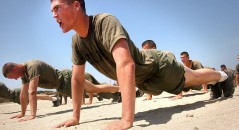 Exercising while pregnant is good for mother and baby. Regular workouts can prepare a mother’s body of the rigors of labor and delivery and ensure faster postnatal recovery. Children born to mothers who exercised during pregnancy also benefit from mom’s healthy habits.
Exercising while pregnant is good for mother and baby. Regular workouts can prepare a mother’s body of the rigors of labor and delivery and ensure faster postnatal recovery. Children born to mothers who exercised during pregnancy also benefit from mom’s healthy habits.
Delivering a baby takes strength and stamina. The fitness gained through a well planned pregnancy workout routine will help both mother and baby during labor. Research indicates that women who exercise during pregnancy tend to have shorter labors and their babies respond better to the stresses of birth.
Exercising mothers have healthier offspring. Time and again studies have shown that babies born to fit mothers have higher Apgar scores. Recent research suggest that children born to mothers who exercise may become healthier adults. Researchers from the US and Germany found people whose mothers exercised when they were pregnant will have healthier blood vessels in adult life.
Strength training during pregnancy can help mothers avoid aches and pains. Pregnant weightlifters can better prepare their bodies for the increased loads they will bare during later stages of pregnancy. The added weight of a growing belly and breasts can distort a pregnant women’s posture and result in joint and muscle pain. Strength training can help a mother-to-be maintain a healthy posture and protect her back.
There is evidence to suggest that regular exercise during pregnancy might prevent gestational diabetes, reduce stress and improve sleep quality.
The many benefits of working out while pregnant may have you motivated to hit the gym. Of course, you should check with your doctor first. For most women a moderate intensity strength training routine will be a perfect fit. In addition to the benefits above, the muscle gain created by strength training will help new moms return to their pre-pregnancey weight.
Tips for strength training while pregnant
Include exercises to strengthen your upper-back. The weight of a growing belly and breasts will often cause women to slump forward. A rounded upper-back can throw off the position of the spine and put undue pressure on the lower back. Strengthening the muscles of the upper-back can prevent this from happening.
Do squats. Squats are a great exercise for any stage of life. The squat is a naturally occurring movement of day-to-day living. Adding squats to a pregnancy strength training regime will ensure that you can stand up and sit down on your own as your body changes. Plus some women choose to squat while giving birth. The position allows your body to work with gravity as you push your baby.
During your 2nd and 3rd trimester avoid crunches. Doing crunches and some other abdominal exercises can put too much stress on your rectus abdominis. The added pressure of these exercises could contribute to a rectus diastasis, a separation of the abdominal muscles.
A well planned strength training routine can keep both mother and baby fit and healthy throughout the pregnancy and beyond. If you are interested in feeling your best during pregnancy and recovering quickly from labor talk to your doctor about strength training.
photo by Swangerschaft




